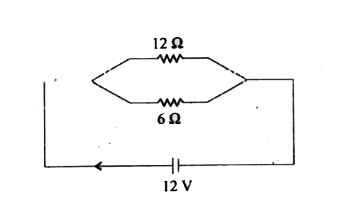NUMERICAL PROBLEMS AND ANSWERS from JEEVITH PUBLICATIONS PHYSICS (KANNADA ENGLISH) CURRENT ELECTRICITY for Class 12
| Class 12 | PHYSICS |
| Chapter | CURRENT ELECTRICITY |
| JEEVITH PUBLICATIONS PHYSICS (KANNADA ENGLISH) | NUMERICAL PROBLEMS AND ANSWERS |
| Medium | English |
| Academic Year | 2023-2024 |
Question 4
A battery of internal resistance 3Ω is connected to 20Ω resistor and the potential difference across the resistor is 10V. If another resistor 30Ω is connected in series with the first resistor and battery is again connectecl to the combination, then calculate the e.m.f and terminal potential difference across the combination..View SolutionQuestion 14
If the number density of electrons in a conductor is 3×1028 and thickness of the conductor is 5 mm, then calculate the current in that conductor for a drift velocity of 2×10−4ms−1. If the voltage applied is 500V, then calculate relaxation time. Given specific charge of electron = 1.76×1011 C kg−1 , length of the conductor = 10 mView SolutionQuestion 15
Two resistors 10Ω and 25Ω are connected in series and the combination is connected across a 25 V source of negligible internal resistance. A voltmeter of resistance 25Ω is connected across the 10Ω resistor. Find the reading in the voltmeter. If another voltmeter of a very large resistance replaces the voltmeter, then find the reading of voltmeter.View SolutionQuestion 17
ABCD forms the four arms of a Wheatstone's network. The arms AB, BC, CD, DA are of 10Ω,15Ω,25Ω and 20Ω respectively. The junctions B and D are connected to the ends of galvanometer of resistance 25Ω. If the source voltage is 5V, r = 0, then calculate the current in the galvanometer. Assume the branch currents across AB, BC, CD, DA and BD as i1,i3,−i4,−i2, and ig respectively.View SolutionQuestion 22
A heating element using nichrome connected to a 230V supply draws an initial current of 3.2A which settles after a few seconds to a steady value of 2.8A. What is the steady temperature of the heating -element, if the room temperature is 27.0∘C? Temperature cofficient of resistance of nichrome averaged over the temperature range involved is 1.70×10−4∘C−1. View SolutionQuestion 24
The earth's surface has-a negative surface charge density of 10−9Cm−2. The potential difference of 400kV between the top of the atmosphere and the surface results in a current of only 1800A over the entire globe. If there were no mechanism of sustaining atmospheric electric field, how much time would be required to neutralize the earth's surface charge? Take radius of earth =6.37×106 m.View SolutionQuestion 27
The figure shows a potentiometer circuit for comparison of two resistances. The balance point with a standard resistor R=10.0Ω is found to be 58.3cm, while that the unknown resistance 'X' is 68.5 cm. Determine the value of x. What might you do if you failed to find a balance point with the given cell of emf ε?
 View Solution
View SolutionQuestion 28
A battery of internal resistance 3Ω is connected to 20Ω resistor and the potential difference across the resistor is 10V. If another resistor 30Ω is connected in series with the first resistor and battery is again connectecl to the combination, then calculate the e.m.f and terminal potential difference across the combination..View SolutionQuestion 29
The figure shows a 2.0V potentiometer used for the determination of internal resistance of a 1.5V cell. The balance point of the cell in open circuit is 76.3 cm. When a resistor of 9.5Ω is used in the external circuit of the cell, the balance point shifts to 64.8 cm length of the potentiometer wire. Determine the internal resistance of the cell.
 View Solution
View Solution



